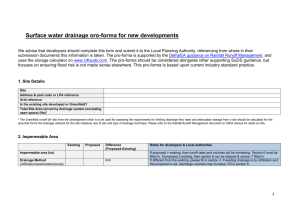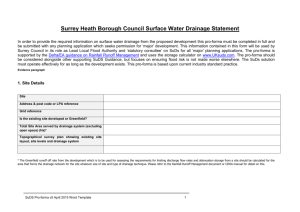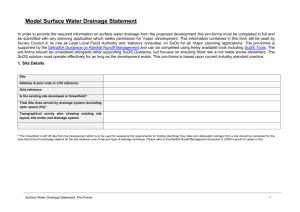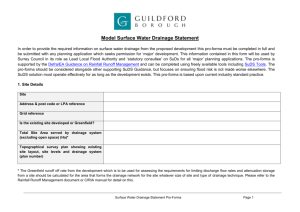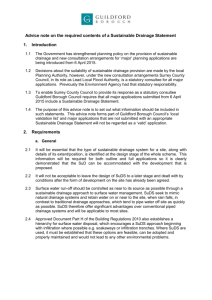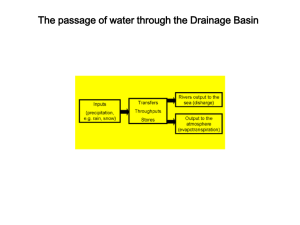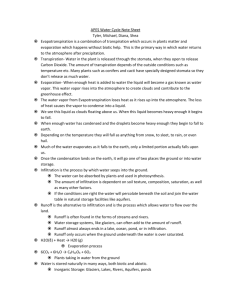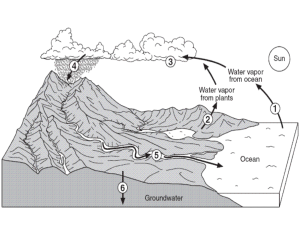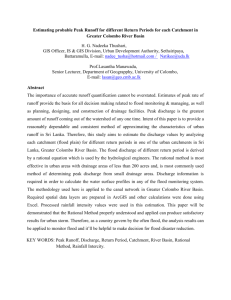Surface Water Pro Forma
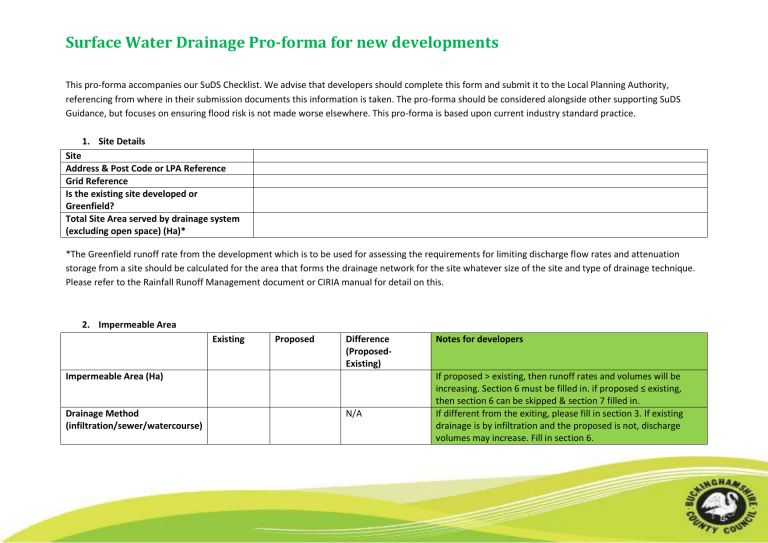
Surface Water Drainage Pro-forma for new developments
This pro-forma accompanies our SuDS Checklist. We advise that developers should complete this form and submit it to the Local Planning Authority, referencing from where in their submission documents this information is taken. The pro-forma should be considered alongside other supporting SuDS
Guidance, but focuses on ensuring flood risk is not made worse elsewhere. This pro-forma is based upon current industry standard practice.
1.
Site Details
Site
Address & Post Code or LPA Reference
Grid Reference
Is the existing site developed or
Greenfield?
Total Site Area served by drainage system
(excluding open space) (Ha)*
*The Greenfield runoff rate from the development which is to be used for assessing the requirements for limiting discharge flow rates and attenuation storage from a site should be calculated for the area that forms the drainage network for the site whatever size of the site and type of drainage technique.
Please refer to the Rainfall Runoff Management document or CIRIA manual for detail on this.
2.
Impermeable Area
Impermeable Area (Ha)
Existing Proposed Difference
(Proposed-
Existing)
Notes for developers
Drainage Method
(infiltration/sewer/watercourse)
N/A
If proposed > existing, then runoff rates and volumes will be increasing. Section 6 must be filled in. if proposed ≤ existing, then section 6 can be skipped & section 7 filled in.
If different from the exiting, please fill in section 3. If existing drainage is by infiltration and the proposed is not, discharge volumes may increase. Fill in section 6.
Surface Water Drainage Pro-forma for new developments
3.
Proposing to Discharge Surface Water via
Infiltration
To watercourse
To surface water sewer
Combination of above
Yes No Evidence that this is possible Notes for developers e.g. soakage tests. Section 6 (infiltration) must be filled in if infiltration is proposed. e.g. is there a watercourse near?
Confirmation from sewer provider that sufficient capacity exists for this connection e.g. part infiltration part discharge to sewer or watercourse, provide evidence above.
4.
Peak Discharge Rates – This is the maximum flow rate at which storm water runoff leaves the site during a particular storm event.
Notes for developers
Greenfield QBAR
Existing Rates (l/s) Proposed Rates (l/s) Difference (l/s)
(Proposed-Existing)
N/A N/A
1 in 1
1 in 30
1 in 100
1 in 100 plus climate change
N/A
QBAR is approx. 1 in 2 storm event. Provide this if section 6
(QBAR) is proposed.
Proposed discharge rates (with mitigation) should be no greater than existing rates for all corresponding storm events e.g. discharge all flow from site at the existing 1 in 100 event increases flood risk during smaller events.
To mitigate for climate change the proposed 1 in 100 + CC must be no greater than the existing 1 in 100 runoff rate. If not, flood risk increases under climate change. 30% should be added to the peak rainfall intensity.
Surface Water Drainage Pro-forma for new developments
5.
Calculate additional volumes for storage – The total volume of water leaving the development site. New hard surfaces potentially restrict the amount of storm water that can go to the ground, so this needs to be controlled so not to make flood risk worse to properties downstream.
1 in 1
1 in 30
1 in 100
1 in 100 plus climate change
Existing
Volume (m 3 )
Proposed
Volume (m 3 )
Difference (m 3 )
(Proposed-Existing)
Notes for developers
Proposed discharge volumes (without mitigation) should be no greater than existing volumes for all corresponding storm events. Any increase in volume increases flood risk elsewhere. Where volumes are increased section 6 must be filled in.
To mitigate for climate change the volume discharge from site must be no greater than the existing 1 in 100 storm event. If not, flood risk increases under climate change.
6.
Calculate attenuation storage – Attenuation storage is provided to enable the rate of runoff from the site into the receiving watercourse to be limited to an acceptable rate to protect against erosion and flooding downstream. The attenuation storage volume is a function of the degree of development relative to the Greenfield discharge rate.
Notes for developer
Volume of water to attenuate on site if discharging at existing rates.
Can’t be used where discharge volumes are increasing.
Storage Attenuation volume (flow rate control) required to retain rates as existing
(m 3 )
Surface Water Drainage Pro-forma for new developments
7.
How is Storm Water stored on site?
Storage is required for the additional volume from site but also for holding back water to slow down the rate from the site. This is known as attenuation storage and long term storage. The idea is that the additional volume does not get into the watercourses, or if it does it is at an exceptionally low rate. You can either infiltrate the stored water back to ground, or if this isn’t possible hold it back with on-site storage. Firstly, can infiltration work on site?
Infiltration State the site’s Geology and known
Source Protection Zones (SPZ)
In light of the above, is infiltration feasible?
Are infiltration rates suitable?
State the distance between a proposed infiltration device base and ground water (GW) level
Were infiltration rates obtained by desk study or infiltration test?
Is the site contaminated? If yes, consider advice from others on whether infiltration can happen.
Yes/No? if the answer is No, please identify how the storm water will be stored prior to release.
Notes for developers
Avoid infiltrating in made ground. Infiltration rates are highly variable and refer to Environment Agency website to identify Source
Protection Zones (SPZ)
Infiltration rates should be no lower than 1x10 -6 m/s
Need 1m (min) between the base of the infiltration device & the water table to protect GW quality & ensure GW doesn’t enter infiltration devices. Avoid infiltration where this isn’t possible.
Infiltration rates can be estimated from desk studies at most stages of the planning system if a backup attenuation scheme is provided.
Water should not be infiltrated through land that is contaminated.
The Environment Agency may provide bespoke advice in planning consultations for contaminated sites that should be considered.
In infiltration is not feasible how will the additional volume be stored? The applicant should then consider the following options in the next section.
Surface Water Drainage Pro-forma for new developments
8.
Storage Requirements
The developer must confirm that either of the two methods for dealing with the amount of water that needs to be stored on site.
Option 1 Simple – store both the additional volume and attenuated volume in order to make a final discharge from site at QBAR (Mean Annual Flow rate).
This is preferred if no infiltration can be made on site. This very simply satisfies the runoff rates and volume criteria.
Option 2 Complex – if some of the additional volume of water can be infiltrated back into the ground, the remainder can be discharged at a very low rate of
2 l/s/Ha. A combined storage calculation using the partial permissible rate of 2 l/s/Ha and the attenuation rate used to slow the runoff from site.
Please confirm what option has been chosen and how much storage is required on site.
9.
Please confirm
Notes for developers
The developer at this stage should have an idea of the site characteristics and be able to explain what the storage requirements are on site and how it will be achieved.
Which Drainage Systems measures have been used?
Drainage systems can contain the 1 in 30 storm event without flooding.
Any flooding between the 1 in 30 & 1 in 100 plus climate change storm events will be safely contained on site.
How are rates being restricted?
Notes for developers
SuDS can be adapted for most situations even where infiltration isn’t feasible e.g. impermeable liners beneath some SuDS devices allows treatment but not infiltration. See CIRIA SuDS Manual C697.
This is a requirement for sewers for adoption & is good practice even where a drainage system is not adopted.
Safely: not causing property flooding or posing a hazard to site users i.e. no deeper than 300mm on roads/footpaths. Flood waters must drain away at section 6 rates. Existing rates can be used where runoff volumes are not increased.
Hydrobrakes to be used where rates are between 2l/s and 5l/s. orifices not to be used below 5l/s as the pipes may block. Pipes with flows <2l/s are prone to blockage.
Surface Water Drainage Pro-forma for new developments
Please confirm the owners/adopters of the entire drainage systems throughout the development. Please list all the owners.
How is the entire drainage system to be maintained?
If these are multiple owners then a drawing illustrating exactly what features will be within each owner’s remit must be submitted with this Pro-forma.
If the features are to be maintained directly by the owners as stated in the answer to the above question please answer yes to this question and submit the relevant maintenance schedule for each feature. If it is to be maintained by other than the above please give details of each feature and the maintenance schedule.
Clear details of the maintenance proposals of all elements of the proposed drainage system must be provided. Poorly maintained drainage can lead to increased flooding problems in the future.
10.
Evidence
Please identify where the details quoted in the sections above were taken from i.e. plans, reports etc. please also provide relevant drawings that need to accompany your pro-forma, in particular exceedance routes and ownership and location of SuDS (maintenance access strips etc.).
Pro-forma Section Document reference where details quoted above are taken from
Section 2
Section 3
Section 4
Section 5
Section 6
Section 7
Section 8
Section 9
Page Number
Surface Water Drainage Pro-forma for new developments
The above form should be completed using evidence from the Flood Risk Assessment and Site Plans. It should serve as a summary sheet of the drainage proposals and should clearly show that the proposed rate and volume as a result of development will not be increasing. If there is an increase in rate or volume, the rate or volume section should be completed to set out how the additional rate/volume is being dealt with.
This form is completed using factual information from the Flood Risk Assessment and Site Plans and can be used as a summary of the surface water drainage strategy on this site.

